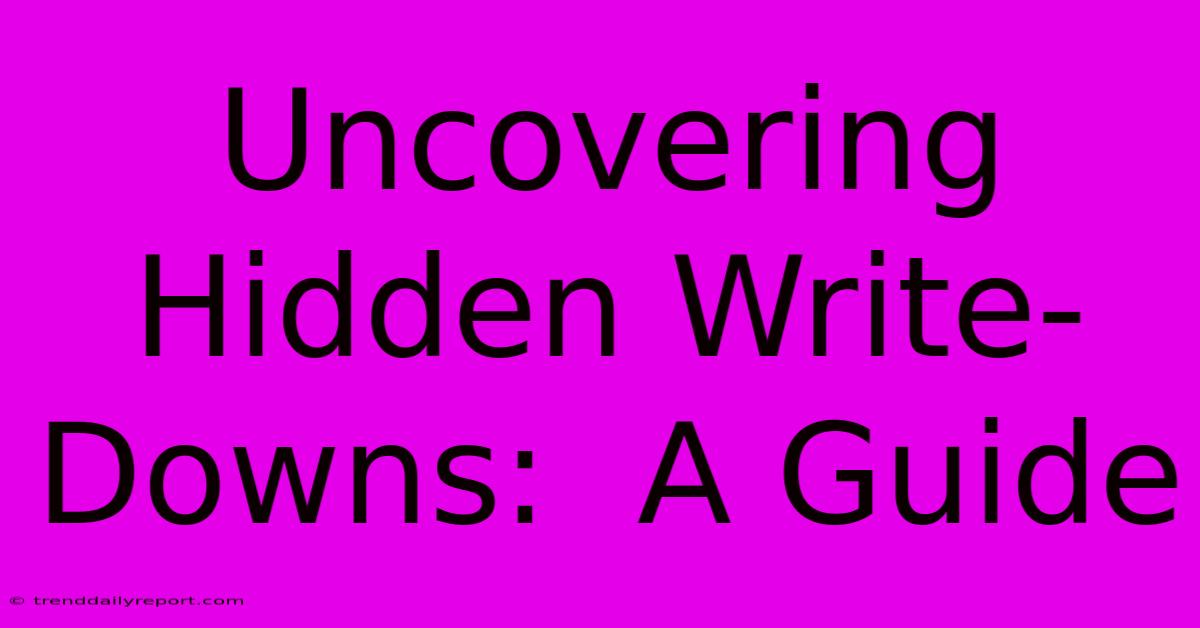Uncovering Hidden Write-Downs: A Guide

Discover more detailed and exciting information on our website. Click the link below to start your adventure: Visit Best Website Uncovering Hidden Write-Downs: A Guide. Don't miss out!
Table of Contents
Uncovering Hidden Write-Downs: A Guide
Hey everyone, so you're interested in learning about write-downs, huh? That's awesome! I've spent years digging through financial statements – trust me, it’s not as glamorous as it sounds – and I’ve learned a thing or two about spotting those sneaky hidden write-downs. Let's dive in.
What Even Is a Write-Down?
Okay, first things first. A write-down is basically when a company decides that an asset – like inventory, equipment, or even a whole business unit – is worth less than what it's recorded on their balance sheet. Think of it like this: you bought a fancy new camera for $1000, but then the model got totally outdated, and now you could only sell it for $200. That $800 difference? That's kind of like a write-down. Companies have to reflect this on their financial statements to give an accurate picture of their financial health.
I remember making a huge mistake early on. I was analyzing a company’s financial statements and totally glossed over some really important details. I thought I was nailing it – I mean, I had the fancy spreadsheets and everything – but I completely missed a significant write-down hidden in a footnote. It was buried in some dense paragraph and I was so embarrassed. Learned my lesson the hard way, let me tell you!
Where to Find Those Sneaky Write-Downs
So, how do you avoid being that guy (or gal)? Here's the lowdown on where to look for those pesky write-downs:
1. The Income Statement:
Look for extraordinary losses or impairments. These aren't always labeled clearly as "write-downs," which can be super frustrating! But they often represent the same thing. A major red flag is a big jump in the expense section that isn't explained properly.
2. The Balance Sheet:
Keep your eyes peeled for changes in the value of assets. If the value of an asset suddenly drops significantly, that's a huge sign. Sometimes, the changes might be subtle, like a decrease in the net book value of property, plant, and equipment (PP&E). You’ve got to be eagle-eyed for that kind of stuff.
3. The Footnotes:
This is where things get real. The footnotes are often where companies disclose the details of any write-downs. I know, it's a snooze-fest, but trust me, it's essential. They often reveal the reason for the write-down – like obsolescence, impairment, or restructuring charges. This provides important context that you can't find in the main statements.
4. The Cash Flow Statement:
Check the investing activities section. Large cash outflows related to the sale of assets at prices significantly below their book value could indicate underlying write-downs.
Why You Should Care About Write-Downs
Let's be honest, if you’re investing, you totally need to understand these. Write-downs can signal a serious problem. It could be a sign of:
- Poor Management: They might have made bad decisions on investments, inventory management, etc. Yikes.
- Industry Changes: The industry might be changing rapidly and the company isn't adapting fast enough.
- Accounting Gimmicks: Sometimes a company tries to “hide” problems and smooth out the income statement.
Understanding write-downs helps you assess the true financial health and profitability of a company. Ignoring these is like driving a car without checking your tires – eventually you're gonna have problems.
Beyond the Basics
Okay, so this isn’t everything you need to know about write-downs – there's a whole lot more to it! But this is a good starting point. I’d recommend you take the time to learn more and practice, practice, practice. Don’t just read about it; actually analyze some financial statements and try to spot some of the clues that I’ve listed above. It takes time and experience, but once you get the hang of it, you’ll be able to spot those hidden write-downs like a financial detective! Good luck!

Thank you for visiting our website wich cover about Uncovering Hidden Write-Downs: A Guide. We hope the information provided has been useful to you. Feel free to contact us if you have any questions or need further assistance. See you next time and dont miss to bookmark.
Featured Posts
-
Trump Names Covid Lockdown Skeptic
Nov 27, 2024
-
Stream Bayern Munich Psg Ucl
Nov 27, 2024
-
Pakistan Beats Zimbabwe By 10
Nov 27, 2024
-
Arsenal Win Salibas 100th Appearance
Nov 27, 2024
-
Where Are Scarlett And Colin Going
Nov 27, 2024
